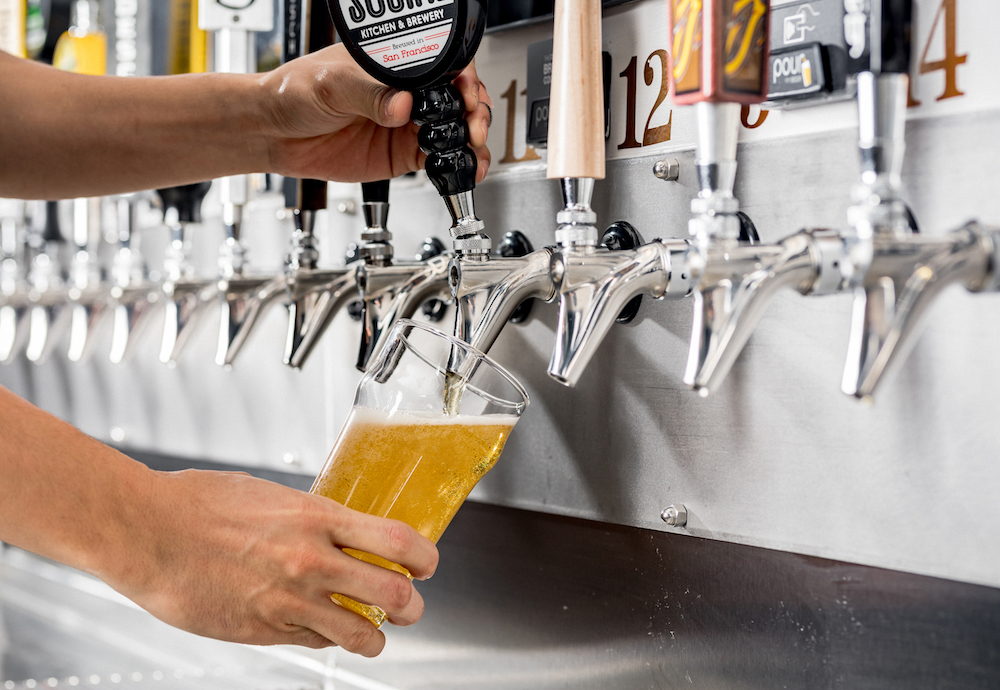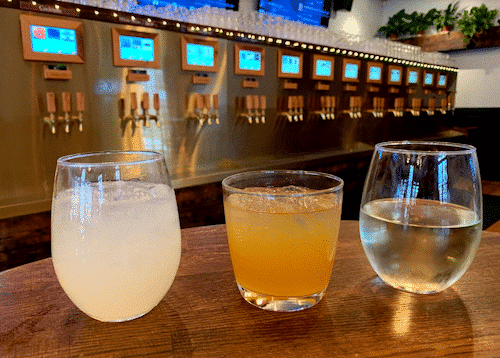The Most Efficient Way to Serve Drinks
On a nice evening in 2008, in Federal Hill, Baltimore, a young entrepreneur, Josh Goodman, sat down at a bar with a few of his friends. After more than 15 minutes of struggling to get the bartender’s attention, the group finally managed to get their first round of drinks.
They quickly realized, however, that it would take just as long or longer to get another round. So, Josh went home, where he began to conceptualize the idea for a drink system that would eliminate the need to wait like this. One that would allow customers to become their own bartenders. Sound familiar?
Examples of undesired bar lines.
That’s precisely where self-pour comes in. In an industry in which customers are accustomed to long wait times, and more sitting than drinking, self-pour beverage walls grant an unprecedented amount of freedom, and capitalize on a number of customer and industry trends in hospitality. Self-pour is a game-changer for both the customers and operators.
COVID-19’s Effect on the Hospitality Industry

Changing Tastes
Owner Benefits
Hundreds of establishments around the world have recognized the shift in the way customers like to experience food and drink, and have made the decision to get their own PourMyBeer self-pour system to delight their customers. These locations have been seeing some fantastic results from their systems, but what exactly are these benefits? Here are some of the biggest ones to consider:
- Cost Reduction: Some of the biggest costs that restaurants and bars incur are labor and operational costs. Particularly with full food and drink service, these costs add up exceptionally. For places that want to make the shift to self-pour, labor and operational expenses reduce drastically. Customers becoming their own bartenders means that wage expenditure is down to zero in that area. Costs ordinarily associated with bottles and other packaging materials are also reduced to near zero.

- Better Service: To a similar point, customers having full control over their drink needs also ensures that they are served with maximal efficiency; no one needs to be left waiting. With traditional bar dispensing, there is a significant amount of opportunity cost associated with patrons waiting to flag down a bartender to put their order in. In many cases, especially on busy nights, this can lead to many simply giving up. With self-pour beverage walls, the moment anyone wants a drink, they immediately get one, without needing a bartender to contend with a growing queue of orders. Your remaining staff can then keep your bar running smoothly 100% of the time.
- Less Waste: There are several types of waste associated with a traditional bar, which self-pour exponentially reduces. Self-pour allows patrons to pour the exact amount they want, which will reduce the amount of alcohol waste generated compared to a traditional bar. Over-pouring and spillage before customers pay for drinks no longer occurs; they now handle their own pours and pay for every ounce they pour. Compared to a bar that serves bottles, taprooms are also much less wasteful when it comes to storage materials.

- Fresh for Weeks: Since kegs with wine and cocktails are pressurized and cooled, they stay fresh for a long time, meaning customers get the same tasting wine on day 30 as they did on day 1. This enhances the customer experience by ensuring that every pour they get is high-quality; it also means that owners are not required to refill and re-keg very often, decreasing the amount of maintenance required in a certain time.
- Eco-Friendly Inventory: Another benefit of self-pour is that using kegs considerably simplifies your inventory. Instead of having to keep track of and later dispose of hundreds of bottles at a time, you’ll have a few dozen kegs (at most) at a time, which are also reusable. This leads to a notably reduced carbon footprint from a self-pour establishment, as very few materials need to be consumed or thrown away.
Customer Benefits
- Convenience: When compared to the traditional bar experience, self-pour has some noteworthy edges on the customer side. Waiting at the bar and trying desperately to get the bartender’s attention for each and every round are not problems customers have to worry about at a self-pour establishment. The idea of customers becoming their own bartenders not only helps establishments reduce labor costs and overhead, but it also means guests have complete autonomy and there is no need to wait for service. With a variety of drink options spread on the beverage wall, several customers can pour their desired drinks simultaneously, meaning no one is waiting and crowding is reduced.
- Consistency: The kegging system that benefits the bar side also makes things nicer for customers. Since every drink is glycol-chilled from the keg all the way to the dispensing tap, every pour made for weeks is completely fresh and cold. This, combined with the fact that customers don’t have to pour full glasses all at once, means that customers can have a more relaxed drink experience in which every single sip is fresh and they don’t have to worry about their beer warming up before they can finish it.
- Fun and Unique Experience: Self-pour is a relatively new and unique concept in the bar and restaurant space, and it very easily becomes a social and interactive experience for guests. Customers often talk to each other about their favorite drinks, how to pour perfectly, and which ones look the coolest. Self-pour’s naturally unique nature relative to the bar experience everyone is used to lends itself to some excitement about experiencing something new. This can be something that benefits both customers as well as establishment owners.
More Than Just Beer

One of the most useful aspects of self-pour technology, particularly with PourMyBeer, is that essentially any drink that can be kegged can also be served on self-pour taps. While many of our customer’s locations do place an emphasis on beer, we’re able to enable them to serve a variety of other drinks as well.
Wine
One of the most common drinks, other than beer, that is served on self-pour taps is wine. It is a drink often in demand at bars, usually in bottles. Draft wine is a very quickly rising trend in the beverage industry, and it has plenty of benefits, just as self-pour beer does. Owners see lots of the same benefits as they do with self-pour beer, including remarkably reduced costs for labor and overhead.
Even better than beer here is the more efficient inventory and reduced waste on packaging materials; while beer is frequently served via kegs at traditional bars, wine is almost always served by the bottle, meaning that each 750ml or so of wine is bottled separately. The benefits of kegging truly shine here. A keg contains about 26 bottles. Those 26 bottles include 39 pounds of packaging waste, including the boxes they came in, corks, and foil wrapping, not to mention the bottles themselves. Using kegs means less cleanup, less mess, and more benefits for the environment.

For the customers, wine on tap can be a great experience, as the wine stays fresh and cold for weeks and each pour tastes like the first glass from a freshly opened bottle.
Cocktails
Cocktails are almost always associated with a bartender making a drink by hand and serving it, one at a time, to customers. They can have plenty of benefits with kegging and self-pour as well. With batch preparation and recipe ratio conversion, cocktails can easily be converted to large keg amounts, and be prepared for self-pour, putting the control into customers’ hands.

On self-pour taps, cocktails are always consistent, and bartenders do not have to worry about making sure the ratio is perfect every single time they make one. Costs and the environmental impact of packaging and storage materials are also reduced with self-pour cocktails, just as they are with wine.
With self-pour taps, you can pour a variety of cocktails on draft from Moscow Mules, Tom Collins, Daiquiris, Old Fashioneds, Manhattans, and Margaritas, to any other drink you can think of!
Check out the video below to see which cocktail is Beast & Brews’ best-seller out of their 100 self-pour taps!
More common recently is serving coffee, specifically cold brew, on self-pour taps. Cold brew is the drink of choice for many and a common alternative to regular coffee because of its reduced acidity (up to 70%). Due to the nature of its brewing style, cold brew stays fresh for weeks unlike regular coffee, and does not spoil as it cools. This makes it a perfect candidate for self-pour. Owners and customers see the same awesome benefits, from reduced cost, better environmental impact, extended freshness, you name it. This is an option that more recently, has become more common in office spaces, many of which go for a PourMyBeer self-pour station to provide self-serve cold brew. Check it out below:
By now, it has become clear that self-pour has developed quite a bit since the spur-of-the-moment idea by Josh Goodman in Federal Hill. Thanks to its remarkable efficiency and convenience for customers, and cost reduction and operational benefit for owners, it quickly grew past a “fad” in the drink industry and has now become the new best way to dispense beverages in the hospitality industry. As the leader of this self-pour revolution, PourMyBeer is proud to have over 12,000 self-pour taps in service and a presence at over 500 locations in 30 countries, including Portugal, Indonesia, Brazil, the U.S., and plenty more!
If you want to learn more about PourMyBeer and the self-pour industry, feel free to browse our website and we encourage you to visit our blog for more resources. You can also contact us at cheers@pourmybeer.com in case you have questions.











